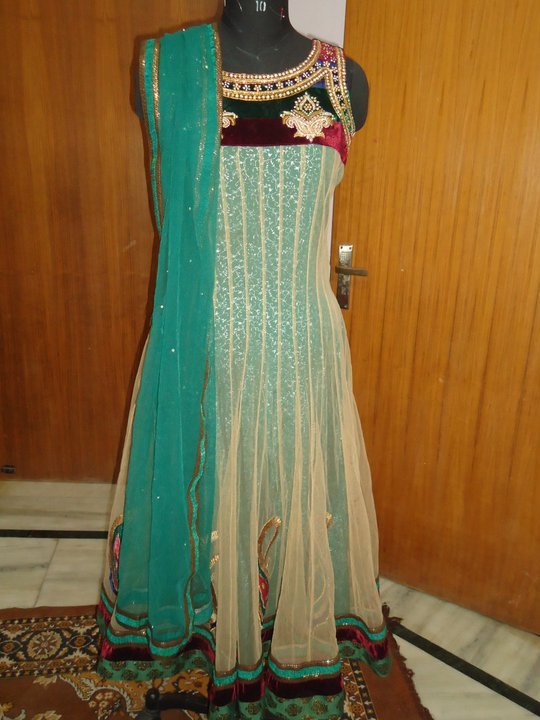Indian Wear Definition
Source (Google.com.pk)A bindi (Hindi: बिंदी, from Sanskrit bindu, meaning "a drop, small particle, dot"), or a pottu/bottu (in Tamil, Telugu, and Malayalam) is a forehead decoration worn in South Asia (particularly India, Pakistan, Bangladesh, Nepal, Sri Lanka and Mauritius) [1] and Southeast Asia. Traditionally it is a bright dot of red color applied in the center of the forehead close to the eyebrows, but it can also consist of a sign or piece of jewelry worn at this location.
Contents [hide]
1 Religious significance
2 Traditional way to apply a bindi
3 Related customs
4 Modern use
5 Alternative names of bindi
6 See also
7 References
8 External links
Religious significance[edit]
Bride with decorated forehead
Traditionally, the area between the eyebrows (where the bindi is placed) is said to be the sixth chakra, ajna, the seat of "concealed wisdom". According to followers of Hinduism, this chakra is the exit point for kundalini energy. The bindi is said to retain energy and strengthen concentration.[1] It is also said to protect against demons or bad luck. The bindi also represents the third eye.[2] It is also used in festivals such as Holi.[3]
In modern times, bindis are worn by women of many religious dispositions in South Asia and Southeast Asia, and is not restricted to Hindus.[citation needed] Many Muslim women in Bangladesh wear the bindi as part of makeup.[citation needed] However, Islamic Research Foundation says "wearing a bindi or mangalsutra is a sign of Hindu women. The Islamic dress code does not permit a Muslim to wear any sign, symbol or mark which is specially significant of a non-Muslim." Women in Pakistan commonly wear decorative bindis to functions and weddings. [4] This is an evidence of how the significance of a bindi has changed over the years and the bindi has become more of a fashion statement in India and countries outside India. The traditional bindi still represents and preserves the symbolic significance that is integrated into Indian mythology in many parts of India.
Red represents honor, love and prosperity, hence it was worn traditionally by women to symbolize this.
The red bindi has multiple meanings which are all valid at the same time. This is also a spiritual symbol.
By one simple interpretation it is a cosmetic mark used to enhance beauty.
From Vedic times, the bindi was created as a means to worship one's intellect. Therefore, it was used by both men and women. The worship of intellect was in order to use it to ensure our thoughts, speech, actions, habits and ultimately our character becomes pure. A strong intellect can help one to make noble decisions in life, be able to stand up to challenges in life with courage, and recognize and welcome good thoughts in life. The belief was that on this a strong individual, a strong family and strong society can be formed.
In meditation, this very spot between the eyebrows (Bhrumadhya) is where one focuses his/her sight, so that it helps concentration. Most images of Buddha or Hindu divinities in meditative pose with their eyes nearly closed show the gaze focused between eyebrows (other spot being the tip of the nose – naasikagra).
Swami Muktanand writes 'auspicious Kumkum or sandal wood paste is applied (between the eyebrows) out of respect for inner Guru. It is the Guru's seat. There is a chakra (center of spiritual energy within human body) here called Ajna (Aadnyaa) chakra meaning 'Command center'. Here you receive the Guru's command to go higher in Sadhana (spiritual practice) to the 'Sahasraar' (seventh and final chakra) which leads to Self-realization. The flame seen at the eyebrow is called 'Guru Jyoti'. (From Finite to Infinite, by Swami Muktananda, SYDA Foundation, S. Fallsburg, NY, 1989, pp. 88–89)
The encyclopedic dictionary of Yoga informs that this 'Ajna Chakra' is also called the 'Third eye'. This center is connected with the sacred syllable 'Om' and presiding it is 'ParaaShiva'. After activation of this center, the aspirant overcomes 'Ahamkar' (ego or sense of individuality), the last hurdle on the path of spirituality. (Encyclopedic dictionary of Yoga, by Georg Fuerstein, Paragon House Publ, NY, 1990, p. 15).
Traditional way to apply a bindi[edit]
A traditional bindi is red or maroon in color. A pinch of vermilion powder applied skillfully with a practiced fingertip makes a perfect red dot. It takes considerable practice to achieve the perfect round shape by hand. A small annular disc (perhaps a coin) aids application for beginners. First they apply a sticky wax paste through the empty center of the disc. This is then covered with kumkum or vermilion and then the disc is removed to get a perfect round bindi. Various materials such as sandal, 'aguru', 'kasturi', 'kumkum' (made of red turmeric) and 'sindoor' (made of zinc oxide and dye) color the dot. Saffron ground together with 'kusumba' flower can also work. Women also wore them if they were married. It would be in the husbands blood.[5]
Indian Wear Image Photo Picture2013

Indian Wear Image Photo Picture2013

Indian Wear Image Photo Picture2013

Indian Wear Image Photo Picture2013
Indian Wear Image Photo Picture2013

Indian Wear Image Photo Picture2013

Indian Wear Image Photo Picture2013

Indian Wear Image Photo Picture2013

Indian Wear Image Photo Picture2013

Indian Wear Image Photo Picture2013

Indian Wear Image Photo Picture2013

Indian Wear Image Photo Picture2013

Indian Wear Image Photo Picture2013
Indian Wear Image Photo Picture2013
No comments:
Post a Comment